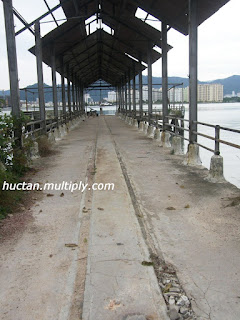战前槟榔屿是欧亚船舶经常停泊的港口,除了客货轮川行外,还有不少帆船和舯舡航行,航运堪称畅通。
Penang is the popular sea port for the berthing of marine vessels from European and Asian countries in the pre-World War time.
Besides commercial passenger and general cargo vessels, there were many junks (sailing vessels) and tongkang (sampan) sailing and moving around the island that created a smooth and complete marine logistic network.
百余年来,槟城对邻近国家的贸易,仍以进行物物交换, 一直到50年代才渐告停顿。泰国的木材,亚齐的槟榔枳,缅甸的仰光豆赂等等,各港口运来槟城或转口的物产是相当的多,船舶多为木造帆船。
The barter trading held between Penang and the neighbouring countries was practiced over the past hundred years until the trading was lessened to a halt by the 1950’s.
Timber from Thailand, pinang (betel nut) from Aceh, beans from Yangoon and lots of imported or tranship native products from other ports were mostly carried by the wooden tongkang.
由欧美英澳,印度日本,中国香汕厦沪等较远地的货物则由大货轮或客货船运来。槟城海墘(Weld Quay),港口码头Sweetenham Pier 的深度在低潮时容不下吃水深的大货轮靠岸, 唯有停在海中, 将货轮内的散杂货物由船舱吊卸到舯舡, 再驳到码头仓库。舯舡业是当年海运中的主要辅助与支线运输工具。
Miscellaneous goods from country that were far away like European countries, USA, Australia; India, Japan; Hong Kong and China such as Shantou, Xiamen and Shanghai were carried by commercial passenger vessels or general cargo ships.
As the depth of the sea water at low tide around Weld Quay and Sweetenham Pier was not sufficient to support the bigger vessels to alongside the harbour, cargo ships had to be anchored at mid sea.
Cargoes were unloaded to tongkang and then forwarding to terminal warehouse. Tongkang in the maritime industry was that the main and auxiliary extension carriers.
舯舡(Tongkang)为大型木造舢板, 船身高度比一般舢板高深, 以便容纳较多货物,由拖船(Tugboat) 拖动营运水域。码头工友(苦力)在海墘(Weld Quay)由舯舡驳运来的货物扛卸到码头仓库或货车, 要不就是把欲出口的货物卸下到舯舡, 再驳到海面的专船载往目的地。
Tongkang was a larger wooden sampan (boat) of which the sidewall was higher than sampan to accommodate more cargoes. Tongkang was towed by tugboat in the trading waters.
Workers (coolies) at Weld Quay were lightering the goods from Tongkang to terminal storage or truck. Goods were also unloaded to tongkang and transhipped to cargo vessels for export to the desired destinations.
80 年代舯舡还很普遍地在海墘运转,至到90年代集装箱运输的普及,船主无货可载,才开始陷入停顿状态。今天槟城海面木造舯舡已告绝迹,被铁驳船 (Steel Barge) 取而代之。
Tongkang were still widely operated around Weld Quay in 1980's. By the 1990’s, due to the common use of container vessels, owner of tongkang could hardly find cargo to carry that the activity of tongkang began to a standstill.
Replaced by steel dumb barges today, sightings of wooden tongkang has been extinct in the sea of Penang.
当年舯舡兴盛时期,槟城造船厂约有几十间,多为华人开设的,散设在北海双溪赖,槟城日落洞,海墘一带。今天在海墘红灯角海滩,可见到被遗弃在烂泥中的旧舯舡,任由风吹日晒,海水冲刷,局部地风化腐烂为烂泥。 想不到当年舯舡的建造工地竟成为它们的葬身之地。
In the glorious times of tongkang, there was a large number of Chinese owned shipyards (shipbuilding industry) performing ship repairing work and construction of wide variety of ship. The industry was scattered at the coastal areas of Prai, Jelutong and Weld Quay.
Today, the abandoned tongkang could be seen around the beach of Weld Quay and Macallum Street. Left under the erosion of wind, drying sun and decay fungi, the tongkang were finally submerged in mud. The previous construction sites of tongkang were finally and unexpectedly became their burial place.

























































